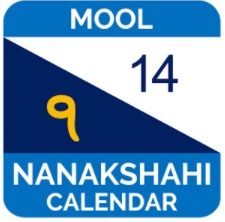Is Mool Nanakshahi Calendar a copy of the Common Era (CE) or the Georgian calendar?
No, Nanakshahi Calendar (approved by the SGPC in 1999) has its own character, it is not a CE or a Georgian calendar. The only thing common with the Christian Calendar is, that Nanakshahi Calendar is also based on the length of the tropical year, so that months do not shift in seasons. Nanakshahi in it’s original presentation, is scientific, correct, and also, very importantly, is based on Gurbani and shall stay according to Gurbani.
The Nanakshahi Calendar is not a copy of the Common Era calendar. We have not adopted the Common Era calendar. The Nanakshahi calendar has its own character. The number of days in the months of the Common Era have been arbitrarily fixed, anywhere from 28 to 31. But in the Nanakshahi Calendar the first five months have 31 days each, based on the fact that the number of days from the spring equinox to the autumn equinox is greater than from the autumn equinox to spring equinox,, and the last seven have 30 days each. In a leap year the extra day has been added at the end of the year. The days in the months of the Common Era Calendar vary from 28 to 31, while Nanakshahi Calendar months have 31 or 30 days. These points make the Nanakshahi Calendar even more scientific than the Common Era calendar. We have adopted the correct length of the tropical year as the basis of Nanakshahi Calendar.The Nanakshahi Calendar is not a copy of the Common Era calendar. We have not adopted the Common Era calendar. The Nanakshahi calendar has its own character. The number of days in the months of the Common Era have been arbitrarily fixed, anywhere from 28 to 31. But in the Nanakshahi Calendar the first five months have 31 days each, based on the fact that the number of days from the spring equinox to the autumn equinox is greater than from the autumn equinox to spring equinox,, and the last seven have 30 days each. In a leap year the extra day has been added at the end of the year. The days in the months of the Common Era Calendar vary from 28 to 31, while Nanakshahi Calendar months have 31 or 30 days. These points make the Nanakshahi Calendar even more scientific than the Common Era calendar. We have adopted the correct length of the tropical year as the basis of Nanakshahi Calendar.
The Common Era Calendar was not started from any particular event from Christ’s life. Christ was neither born on January 1, nor was he born in the year 1 of that calendar. Most Christian scholars agree that 4 BCE is the year of nativity of Christ. Christians simply adopted the Roman calendar which had been reformed by Julius Caesar (Julius Caesar discarded the lunar calendar and instituted the calendar based on the length of the solar year known at that time) , and implemented by him in 45 BCE. Because of the gradual adoption and use of this calendar, it came to be known as the Julian Calendar, which in the lands of Christendom was the calendar of Christianity. Its starting date has nothing to do with the birth of Christ or any event from his life. The abbreviations BC and AD became current because the year after 1 BC was mistakenly taken as Christ’s birth. The Julian Calendar continued without break until 1582 CE.
This calendar came to India along with the English, and thus in India, it came to be known as English Calendar. Now its reformed version known as Gregorian calendar is in use throughout the world. In relation to the seasons, the yearly error in the Bikrami calendar is even greater than what it was in the Julian Calendar for which error the Julian Calendar was revised.
Christians do not call their calendar the Christian Calendar anymore. Since its adoption throughout the world, it is now called the Common Era Calendar.
The count of the Samvat of the Nanakshahi calendar is from year of birth of Guru Nanak Sahib. The month of Chet is chosen because Baramaha Tukhari, Baramaha Manjh, and Ruti Slok banis start with the month of Chet. Nanakshahi Calendar is based on Gurbani. Its months will no longer shift in seasons.
Why shouldn’t we then adopt the Common Era calendar which is in use throughout the world?
Every faith has its own identity, months of the year, the festivals we celebrate are all a mark of our cultural identity. After all the Gurbani refers to Chet not to March. What we needed to do was to adopt the tropical year, as is done to the Common Era calendar which conforms to seasons, and use it as a base for our festivals in a calendar that espouses our own identity. For the children growing up now it will be easy to remember the dates of Gurpurbs as they have been fixed in the new calendar. This will strengthen the new generation’s association with the religion.
The frequently asked questions based on these answers and the data behind the evidence are based on published papers, evidence, and research by thought leaders, subject matter experts, historians and scholars in the field. See additionalPal Singh Purewal’s responses to Interview with Indian Express|Gurmit Singh |Mr. Lamba|Tara Singh|Harcharan Singh
